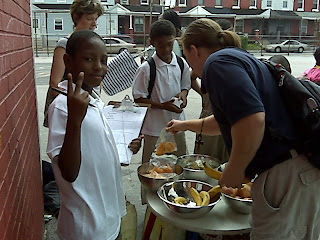I arrived at the Lawton Family Farm on Saturday morning, catching a ride from Warren, MA with Terri's sister, Danielle, who had kindly hosted Ollie and I (and our ridiculous amount of gear) the evening before, and who filled me in on the family's history of dairy farming. She and Terri -- the driving force behind Oake Knoll Ayrshires (a raw milk production operation at her family's farm in Foxboro) -- had always been around farmers, been actively involved in their local 4-H organization, and since the 80s when their father converted the farm to a dairy, been around cows. This family knows dairy. (If ever there's a farm trivia night at Wonderland when I get back to DC, I know who I want on my team for the round on bovines.) Terri's degree in Animal Agribusiness and her time as a state dairy inspector have informed her professional practice, but she also clearly really cares for her cows. She names every cow and is acutely aware of the quirks of each; the cows, in turn, seemed comfortable and even a bit curious around various members of the family, and me when I made my way to the pre-milking area. The milking routine moved like a well-oiled machine: the cows waited outside the milking barn until the gate was lifted, then they marched in, found the nearest empty spot, and poked their heads through one of the 12 headgates to nibble on a small pile of grain. The milkers -- Ed and Nancy -- cleaned and sterilized the udders and teats, then hooked the cows up to the milking machines. When the whole group was done, the teats were disinfected once again, the cows unhooked, and everyone marched out the far end of the barn to make room for the next cadre. Amazing.
Terri is very much connected not only to her cows but also to her community of raw milk drinkers who regularly come by the farm to pick up their pre-ordered fresh milk. One afternoon, she told me of a recent time when the price of organic oats and grain (which she uses to supplement the cows' main diet of forage -- grass and hay) rose sharply from $5 to $30 over the course of two months: she took a poll among her loyal customer base to see what they wanted to do. Of the options -- 1) start feeding the cows conventionally grown oats and grain, 2) start feeding them organic corn and soybeans, or 3) let the cows attempt to subsist on a diet of grass and hay alone (which, it turns out, means that they lack key nutrients) -- the group as a whole decided to abandon the organic feed (option 1) in order to keep the cows happy, healthy, and productive. Democracy in action.
I was surprised to learn from Terri's mom that, contrary to what I'd read in books like Fast Food Nation and The Omnivore's Dilemma, cows actually love corn. They will seek it out. If they get loose in a field, I was told, they will always go for the sweet-tasting, easily accessible calories of a corn stalk over the usual grass. (Yes, I know corn is a grass, technically, but there are different chemical things going on that make corn especially appealing... and complicated. There is a good deal of debate among those who raise cattle as to whether chopped corn stalks -- a common component of the diet of conventionally-raised cows -- count as "grain" or "forage" or some combination of the two.) This doesn't mean cows *should* eat corn, or if they do, certainly not anything close to what they are stuffed with when crammed into the typical beef cattle feed lots. For her part, Terri avoids feeding corn products to her herd, a practice which is both more expensive and requires more work to locate appropriate alternatives for her cows. But the decision has philosophical and financial underpinnings for her business, and Terri continues to nourish her cows without corn products.
Speaking of nourishing, I was put on calf-feeding patrol the last morning at the farm. Apparently Ed and Nancy thought I could hold my own after Nancy and I had successfully fed the group the previous morning, so they sent me into the calf barn with a big bucket of fresh milk and a bottle. (In retrospect, I think they might have been mildly hazing me.) Hilarity ensued as the calves proceeded to knock each other (and me, almost) over in the feeding frenzy. I tell you, those little guys are hungry. Whitey got his head stuck in the bucket at one point, while one of the other calves tried to headbutt the bottle out of the mouth of the calf I was feeding as another of the calves jumped on his back, the last little guy nibbling on my fingers and then, when that didn't work, my pants. Total chaos. I was seeing the "suck or die" instinct in action. I'd heard about this principle of calf behavior -- not to be confused with the Republican Party's motto -- during my time at the Abbey, and have found the aggressive nursing instinct to be pretty intense. But I made it out alive and all five calves were fed. Whew!
I purchased a small container of the farm's newly marketed fromage blanc and tossed Ollie into the back of Ed's truck: I'd managed to hitch a ride into Boston during Ed's regular brewer's grain pick-ups. (Hey, I'm biking *most* of the way around the country, but I'll hitch a ride here and there with folks going my way. And after the intensity of the morning's calf riots, I was glad for the rest.)
Sent from my Verizon Wireless BlackBerry




















